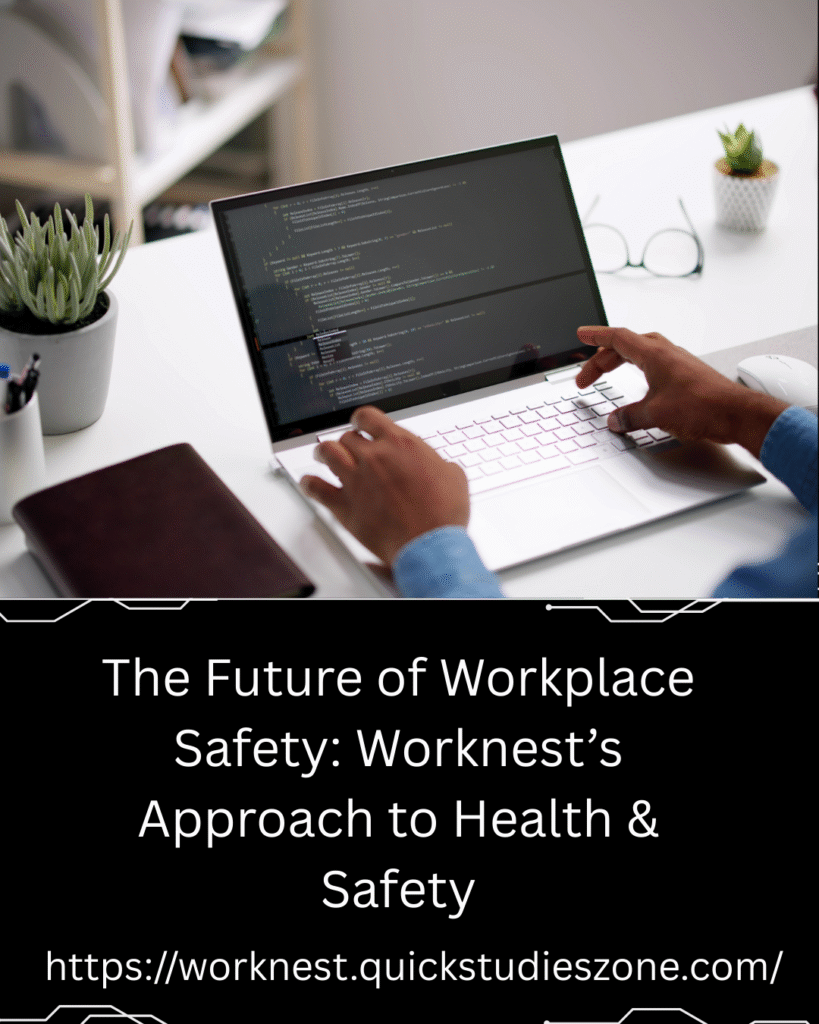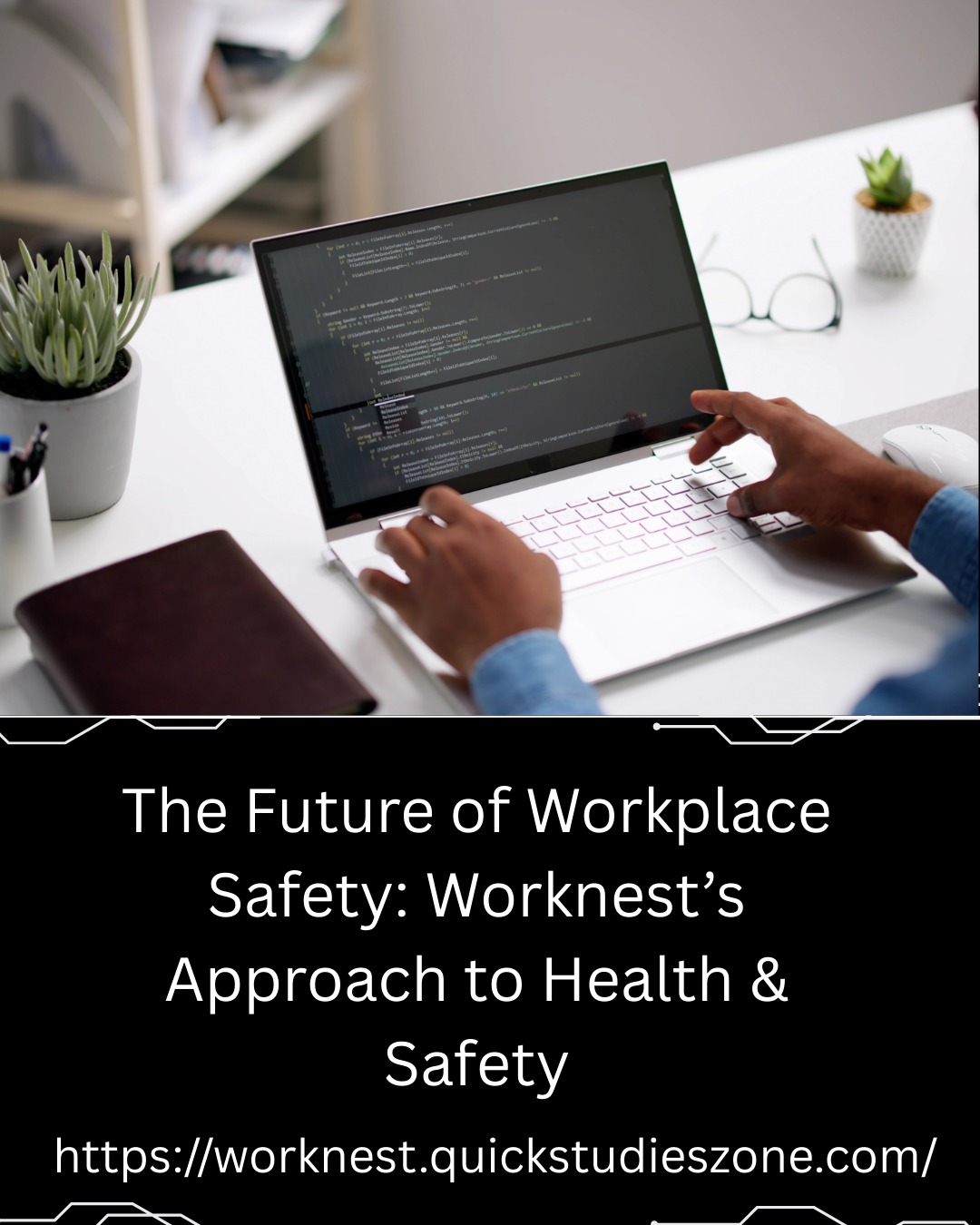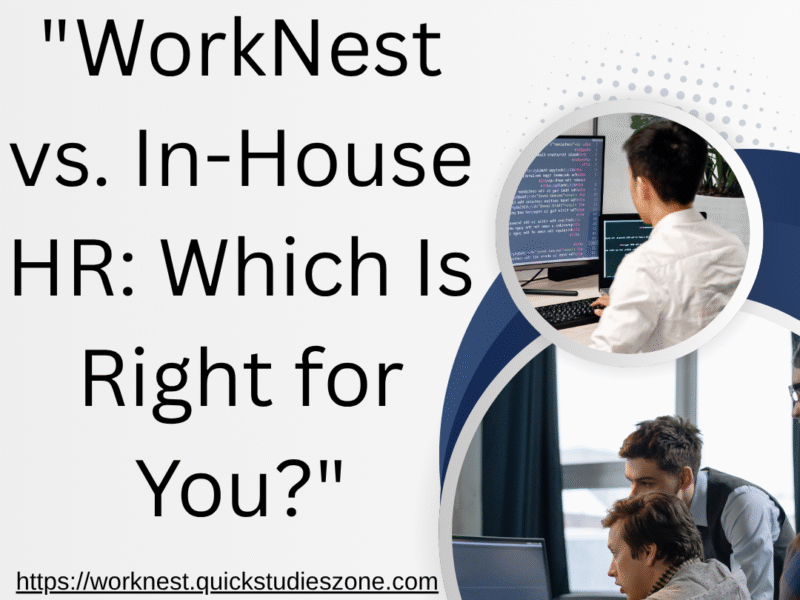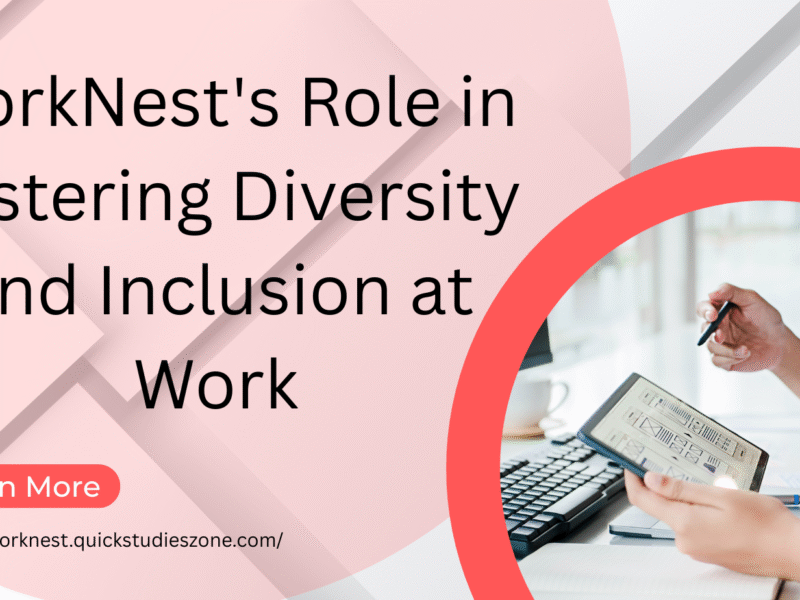Workplace Safety in the Future: How Worknest would look into Health and Safety
Introduction
Workplace safety is no longer a compliance box in the modern business world that is moving at high speed, and is a crucial catalyst of organizational growth, operational health, and esteem. The Future of Workplace Safety: Worknest’s Approach to Health & Safety. As new technologies, new laws, and new demands of workers, governments, and the general population emerge, many strong forces are influencing the fate of the workplace safety.
Worknest being a progressive organization has been creating and introducing an integrated, proactive and human being friendly approach to health and safety that puts it ahead of many of its counterparts. This blog post explores the changing trends of workplace safety, issues and opportunities, and, most crucially, the way the model of Worknest is designed to be on the forefront.
Part 1: The Present Economies of Workplace Safety.
1.1 Drivers of Change
There are a number of drivers of change in the way organizations are conceptualizing safety:
Regulatory pressure. Governments are everywhere becoming stricter in health and safety laws, raising penalties, demanding more open reporting.
Worker expectations. Employees desire healthy, safe, and supportive environments at work which include mental health, ergonomical comfort, and safety culture.
Public scrutiny. The risks are amplified by social media; incidences that go public usually harm brands.
Technology possibilities. IoT sensors can be used to predict and monitor safety incidents, and AI-based risk analytics can be used to prevent them.
Cost pressures. Workplace injury, illness or downtime cost the companies in compensation, legal, delays, insurance. This is much less expensive in prevention.
1.2 Common Challenges
Nevertheless, in spite of these drivers, numerous organizations have difficulties with:
Reactive safety cultures. Leaving accidents to occur and then taking action.
Siloed systems. Health, safety, environment, quality, which are often managed independently, restrict the overall risk view.
Limited use of data. Ineffective data gathering, disintegration, and real time tracking.
Ignoring human factors. Ergonomics, behavior, mental health not dealt with in a systematic fashion.
Lack of employee engagement. Employees can be made to feel that the policies regarding safety are put on their heads without their contributions.
1.3 Trends We’re Seeing
The following are some of the trends that will be influencing the health and safety in the future:
Predictive analytics and AI. Predictive analysis of the location where incidents are likely to occur so that preventive action is possible.
Wearables and IoT. Intelligent devices that are able to sensory track the health, fatigue, and environmental risks of workers in real time.
Digital twins. Simulation of risks in virtual workplaces to plan safe layouts, evacuation routes, etc.
AR, VR. To train, simulation of exposure to hazards without actual subject exposure to hazards.
Psychosocial safety, mental health. identifying stress, burnout, harassment or discrimination as safety risks.
Inclusive safety. Creating a safety design that considers the different workforces: age, physical ability, culture.
Sustainability connection. Healthy workplaces are also green, conflicts of interests (ex: clean air, ergonomics, reduction of wastes).
Part 2 Principles of the Future of Workplace Safety.
Based on the research studies and already tested implementations, some guiding principles may be outlined in the future:
Proactive vs Reactive. Stop responding to the events, to taking care of them in advance.
Data‐driven decision making. Make resource allocation, continuous improvement, and risk assessments based on timely and precise data.
Worker involvement. Involving employees in safety planning, close call reporting.
Holistic health. Ergonomics, environmental safety and physical and psychological health.
Integrated systems. Integrated systems on safety, compliance, environmental risk, quality, etc.
Adaptive learning. Organizations are required to learn not only through the incidents, but also by near misses, simulations, and benchmarking.
Technology leverage. Utilizing technology correctly (not because it is a good thing in itself) to diminish risk, improve prevention, not merely to track.
Part 3: Approach of Worknest -The way it is shaping up.
Against this background of trends and principles, Worknest has formulated a multi pronged health and safety approach. The following are the main elements of the strategy of Worknest, the manner in which they operate and how they plan ahead.
3.1 Vision & Mission
Worknest is of the opinion that the value of safety is not something secondary. This is in its mission to make sure that every employee no matter the place of work, position or seniority of the employee is in an environment where hazards are reduced, health is preserved and wellbeing is encouraged. Leadership commitment and organizational culture are some of the ways of this vision.
3.2 Governance & Policy
Leadership accountability. In Worknest, the high management is accountable (and in charge) of safety outcomes. Leadership KPIs include safety goals.
Well defined policies and standards. WorkNest has come up with policies which discuss physical safety, ergonomics, mental health, emergency response, environmental safety. These standards do not remain constant, but they are subject to changes with regulations and best practices.
Compliance + more compliance. Worknest does not just comply with necessary legal standards, but frequently exceeds local legal minimum standards by one or more step into the international best practice (ISO standards, etc.).
3.3 Risk Assessment/Hazard Prevention.
Comprehensive risk mapping. Worknest performs frequent and thorough hazard evaluations, including physical hazards, chemical hazards, biological hazards, ergonomic hazards, psychosocial hazards.
Use of predictive tools. The risks are detected early with the help of data analytic tools, employee feedback, near-miss reports, and environmental sensors.
Control measures hierarchy. Focus on getting rid of the hazards where they can be gotten rid of, replacing less hazardous options, engineering controls, administrative controls and finally PPE.
3.4 Technology & Innovation
iot sensors and environmental measurement. Worknest uses sensors to check air quality, noise, temperature, humidity, chemical exposure, and so forth. Automatic alerts are raised when the thresholds are breached.
Wearable tech. In higher risk positions, wearables are used to track fatigue, posture, position (when working alone), falls, etc.
AR/VR training simulations. Simulation of working in hazardous conditions (confined spaces, elevated heights, emergencies) with the help of VR headsets with empowering employees to train safely.
Analytics and data dashboards. The managers can monitor the safety-related measures in real time: incident rates, near misses, risk rating, compliance rates. AI/ML can be used to forecast the probability of an incident happening in the future.
-
3.5 Employee Engagement/Culture.
Safety champions. WorkNest assigns safety ambassadors to teams, who will encourage safety conversations, report safety hazards, encourage peer responsibility.
Employee feedback loops. Employees are advised and given the power to report near misses, unsafe working conditions, and improvement suggestions without being chastised.
Training & awareness. Periodic trainings, refreshers, toolbox talks; not only initial training but also on-going and scenario based.
Wellbeing programs. Mental health support programs, stress management programs, ergonomic evaluations, flexible working where applicable.
3.6 Continuous Improvement and Incident Investigation.
Root‑cause analysis. All the incidents (minor or major) are examined in detail to identify the root cause (systemic or cultural), not the proximate.
Learning from near misses. Near misses are considered learning opportunities which are critical. Patterns are tracked.
Audits and benchmarking. Worknest engages in external audits, peer benchmarking and is modifying its standards on this basis.
Feedback loop to design. Design of facilities, processes, acquiring equipment include feedback of incident investigations, employee suggestions and monitoring.
3.7 Mental Health/Psychosocial Safety.
Worknest realizes that the concept of safety goes beyond the aspect of physical integrity. Key practices include:
Leader and employee mental health awareness training.
Counselling, EAP (employee assistance programs).
Observing signs of work overload, extreme tiredness, interpersonal strife.
Clear reporting, response policies against harassment, bullying, and discrimination.
3.8 Sustainability/ the Environment.
Worknest is aware of the fact that the environmental health intersects with the worker health: air, chemicals, waste, noise, etc. Its strategy includes:
Using materials and non-toxics when possible that are eco-friendly.
Reducing pollution and pollutants at work.
Planning work environments in a good way to be ventilated, lit up, comfortable.
Making the safety programs consistent with sustainability objectives (zero waste, energy efficiency, etc.).
Part 4: The New Technologies and the Preparations of Worknest.
Worknest is investing and testing various emerging technologies and practices to be on the frontline.
4.1 Artificial Intelligence and machine learning.
Predictive risk modeling. The Future of Workplace Safety: Worknest’s Approach to Health & Safety. Training models based on historical incidents data that might predict high-risk operations, times, or conditions.
Image and video analytics. The cameras monitoring the worksites will be able to automatically identify unsafe behavior (workers not wearing PPE, tool use, unsafe posture) and issue warning messages.
4.2 Internet of Things (IoT) and Smart Environments.
Machines, tools, environmental sensors to sense dangerous gas leakages, overheating, stresses on the structure.
Wearables which check vital signs, worker location (lone worker safety), movement trends.
4.3 Augmented Reality (AR) / Virtual Reality (VR).
VR to train hazards that can be immersive (fire, chemical spill, confined space rescue, etc.).
AR to support workers with complicated tasks: e.g. overlaying instructions, safety checklists; make it possible to guide workers remotely.
4.4 Digital Twin & Simulation
Designing digital models of facilities to be used to simulate various in-use situations, test layout changes, evacuation routes, emergency response.
Visualize the movement of crowds, equipment placement, workflow to reduce hazards using simulation.
-
 4.5 Wearable Robotics & Exoskeletons.
4.5 Wearable Robotics & Exoskeletons.In physically strenuous work, exoskeletons to help with lifting or posture aids to prevent musculoskeletal injuries.
4.6 Big Data and Analytics Platforms.
Integrating environmental sensor data, health record data, training data, incident report data to create data-based safety dashboards.
Trend analysis to make decisions using KPIs.
Part 5: Case Studies / Illustrative Examples.
These are hypothetical or actual cases of how the approach of Worknest works out in reality.
5.1 Case Study A: Manufacturing Plant.
Scenario: A big production facility that has assembly lines, heavy machinery, use of chemicals.
Difficulties: The mechanical accidents, the exposure to chemicals, ergonomic stress, the noise levels, the exhaustion of the workers.
Worknest’s Interventions:
Installed environmental sensors to check the airborne particulates and chemical vapors; the sensors alert the automated ventilation and warning in case of exceedances.
Launched wearable devices that check the sound levels and warn about long-term excessive exposure that is above the safe limit.
Introduced AR to assist technicians to observe safety checklists in the process of undertaking maintenance on heavy equipment.
Postural safety training; rotating shifts to eliminate repetitive stress.
Check-in mental health programs and fatigue management programs of shift workers.
Outcomes:
Less frequent incidences, less work loss.
Better employee morale, reduced turnover.
Reduced insurance rates, improved regulation.
5.2 Case Study B: Field or remote Workers.
Scenario: Onsite employees (construction, energy, mining) who have remote locations, unpredictable environmental factors, individual work.
Difficulties: Workers alone; environmental risks; unforeseen weather conditions; communications; and delay of emergency responses.
Worknest’s Interventions:
Offer wearables that have GPS, fall detection, vital signs, automatic emergency warning in case something wrong happens.
Inspect remote infrastructure with drones, and periodic remote surveys to ensure that there are no hazards.
Hazard reporting and real time check-in mobile applications.
VR field safety, equipment-use pre-deployment training.
Extreme weather protocols of mental health support and rest / hydration.
Outcomes:
Quick response and detection.
Less serious injuries.
Increased morale and safety of remote workers.
Part 6: Measuring Success
Worknest employs a set of measurements and assessment techniques to make certain out that safety programs are, at any time, effective and in the process of improvement.
6.1 Key Performance Indicators (KPIs).
Some of the core KPIs include:
Frequency of Lost Time Injury (LTIFR).
Total Recordable Incident rate (TRIR).
The number of near misses reported.
Response to safety incidents.
Safety training rate of completion.
Job satisfaction / Worker attitude towards safety climate.
Environmental indicators: air quality, levels of exposure to chemicals.
6.2 Leading versus Lagging Indicators.
Worknest focuses on leading indicators that forecast issues (e.g. near miss reports, safety audits, attendance at safety meetings) instead of only concentrating on lagging indicators (injuries, incidents).
6.3 Audits and External Checking.
Periodic cross-functional teams that carry out internal safety audits.
External audit or certification (e.g. ISO 45001, OSHA or any other) to guarantee compliance and best practice.
6.4 Feedback & Learning Loops
Post-incident and post-near miss debriefs were carried out; lessons disseminated throughout the organization.
Employee surveys to determine safety perception, improvement recommendations.
Application of failure / incident data to modify process, training, design.
Part 7: Future threats and obstacles.
Despite a powerful approach there are difficulties that need to be solved.
7.1 Data Privacy and Ethics
Smart watches/ bracelets and health tracking produce personal information; require policies, consent, privacy.
Trade-offs between safety and surveillance: the risk of employee distrust when monitored seems like an invasion of privacy.
7.2 Technology Adoption Costs
Sensors, wearables, AR/VR, infrastructure could be initially expensive.
Requirement of constant maintenance, calibration, software change.
7.3 Resistance to Change
Organizational inertia: individuals used to do things in a particular manner.
Skills deficiency regarding new technologies, training and culture change will be required.
7.4 Overreliance on Technology
Technology may deceive or give false positives / negatives.
Requires human supervision; human culture and active human interaction is crucial.
7.5 Regulatory and Legal Uncertainties.
Regulations can keep up with the introduction of new technologies; the questions of liability, standards, acceptable practice can be uncertain.
Part 8: Recommendations and Best Practices to other Organizations.
Based on the experience of Worknest, the following are proposed best practices to adopt by other organizations that are interested in the future of workplace safety.
Begin with the commitment of leaders. The safety should be regarded as strategic and must be entrenched in the top levels of management.
Engage workers deeply. The risks that are seen by those doing the work are often not seen by management. Promote reporting, feedback, involvement.
Have a wholesome outlook of safety. Make it mental, emotional, ergonomic, environmental- not only accidents and injuries.
Invest in the appropriate technology. But do ensure that it addresses real problems, it is compatible with the current systems and can be scaled.
Use data wisely. Collect the appropriate metrics, leading and lagging, interpret trends and take action.
Establish lifelong learning. Receive near miss lessons, audit, feedback. Revise processes regularly.
Focus on sustainability, health. Greener, healthier and cleaner work places are beneficial to both people and the planet.
Make certain of ethical and transparent monitoring. Create the policy of privacy, access, usage.
Part 9: What the Future Maybe Like (10-15 Years Ahead)
Going even further to the future, supposing that the organizations such as Worknest keep developing:
Autonomous safety systems. Embedded hazard-detecting buildings that automatically adjust (ventilation, lighting, layout) to mitigate the risk.
Fully immersive training. Application of VR/AR and possibly haptic feedback so that workers get to feel the response of hazards in safe conditions but in reality-like environments.
Wearable biomonitoring. Identifying the initial symptoms of disease or stress (e.g. heart rate variability, cortisol sensors) as a means of avoiding health catastrophes.
Robot collaborations. Exoskeletons or robots replace dangerous jobs, human beings monitor or perform less dangerous jobs.
Live compliance with regulations. Automatically auditing compliance systems, generate reports, remind managers about non-compliance.
Work design health. Human circadian rhythm, rest, social affiliation, psychological security as the norm in workplaces.
Unification of global safety standards. Many multinational organizations are expanding therefore, global standards, which are perhaps more cohesive, regardless of local law, may become expectation.
Conclusion
The workplace safety is at a crossroad: the expectations are growing, the technology is evolving, yet the risks and the expenses in case of falling behind are growing. The Future of Workplace Safety: Worknest’s Approach to Health & Safety. To succeed, organizations will have to go beyond merely complying and responding; they will have to make safety integral to culture, make smart use of technology, make employees more engaged, and have a holistic understanding of safety, the physical, the mental, the environmental.
The philosophy of WorkNest, which is deep rooted in the proactive management of risks, technology, human-centered design, and continuous learning, is a solid example of what the future of workplace safety might look like. Incorporating any of the components of this model can imply safer, healthier, and more resilient operations to any organization.
You can do so (e.g. in Pakistan, to small businesses, or to a specific industry) or even shorter (e.g. executive summary) versions of this post. Would you prefer that?


